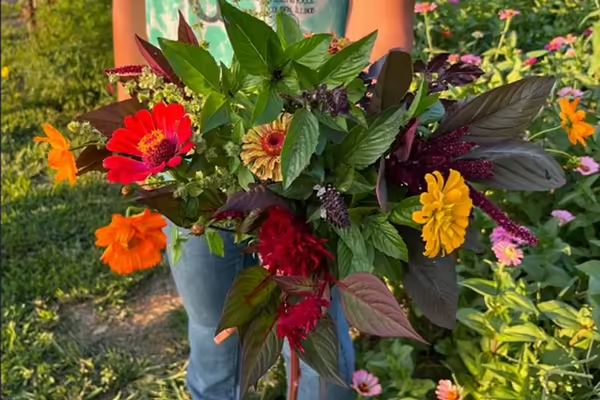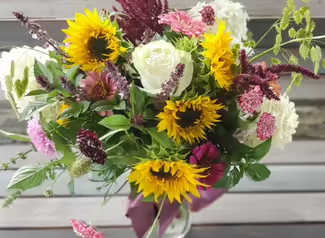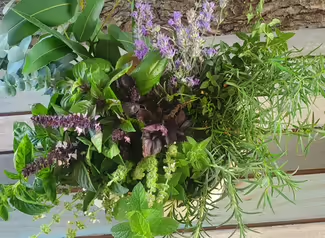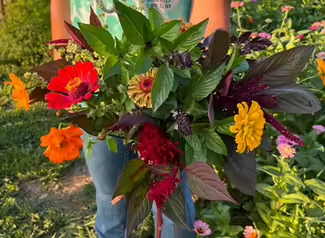
URBANA, Ill. — Cultivating a cut flower garden filled with favorites can be a fun family project that can become budget-friendly gifts for everyone. Adding herbs to a garden and bouquets will create a unique, personal touch to designs. Fresh herbs look and smell amazing and will be long-lasting in your designs.
Herbs can symbolize a sentiment you need for a bouquet. In the Victorian era, a bride might carry a fresh bouquet of lavender, representing luck and devotion. Adding rosemary to a bouquet symbolizes remembrance and sage for a long life. Mint is known for its calming effect, making it an ideal addition to a nervous blind date bouquet. Using herbs to signify meaning can add an uplifting touch to every flower bouquet.
Five tips for arranging cut flowers and herbs
- Cut the stem with sharp clippers. The ideal time for harvest is in the morning once the dew has evaporated and before the sun dissipates its oils.
- Strip any leaves that are near the bottom of the stem. Excessive leaves must be stripped away so they are not in the water. Have a bucket of water ready to plunge the stems of flowers or herbs at harvest. This is especially important in the heat of the summer months, as blooms and greens can wilt quickly.
- Allow flowers and herbs to hydrate before arranging. Pick out the vessel you plan to arrange the bouquet in during this time. A vintage blue mason jar is a summertime favorite that can be personalized by jute string or a colorful ribbon. But many have an eye-catching glass or pottery piece waiting for their bouquet.
- Snip the ends at a 45-degree angle to give them a fresh cut. Now, to make an arrangement. Set clippers, the bucket of herbs and flowers, and the vessel with water and preservative solution one inch from the top on a kitchen counter or table. Create a ring of herbs or greens angled out from the container edge. The herbs will act as a foundation for the rest of the elements. Add flowers to that outer ring and continue working inward until the center is filled last. Begin with the focal flower or the thickest stem, add filler flowers that give texture and fullness, and add any small wispy herbs or airy flowers.
- Re-snip ends and change the water. Extend the life of the flowers and herbs to make the arrangement last longer by re-snipping and changing the water after a few days.
Mixing herbs and flowers while making aromatic bouquets is gratifying and a great way to use herbs past their prime for culinary use in the kitchen. The practice can save on budgeting as it uses plants in multiple ways. Any herb might be used to spice up your arrangement, but some suggested herbs that hold up well in bouquets after being hydrated are:
- Basil – cinnamon, lemon, cardinal, and purple.
- Dill – fernleaf and bouquet.
- Rosemary.
- Lavender.
- Mint – chocolate, apple.
- Sage – green or variegated.
- Artemisia.
Adding herbs to a garden or landscape can spice up any flowers blooming in a space. Gardening is about enjoying nature, the smell of things growing in the soil, and harvesting the bounty. Use flowers and herbs to create unique, colorful, neutral, or edible bouquets this gardening season.
For more on flower varieties and characteristics, visit extension.illinois.edu/flowers. For questions, connect with a location Extension office at go.illinois.edu/ExtensionOffice.
Christina Lueking is an Illinois Extension horticulture educator for Bond, Clinton, Jefferson, Marion, and Washington counties. Gardeners Corner is a quarterly newsletter from gardening experts around the state. Each issue highlights best practices that will make your houseplants, landscape, or garden shine in any season. Join the Gardener’s Corner email list at go.illinois.edu/GCsubscribefor direct access to timely tips.
PHOTO CAPTION: Think outside the box and add herbs to your garden or landscape that can spice up any flowers blooming in your space. Photos: Christina Lueking, Illinois Extension.Photos are available for media download.
Illinois Extension leads public outreach for University of Illinois by translating research into action plans that allow Illinois families, businesses, and community leaders to solve problems, make informed decisions, and adapt to changes and opportunities. Illinois Extension is part of the University of Illinois Urbana-Champaign College of Agricultural, Consumer and Environmental Sciences.


